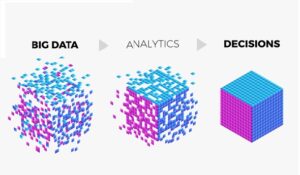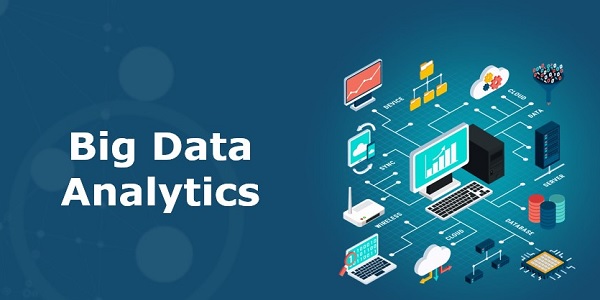Collecting the information from the internet is the process of Data Collection. Almost 3-4 million data mean 30-40 lakh terabytes data generated by us, in the present situation.
WHAT IS BIG DATA?
Big data is data sets that cannot be processed, stored, and analyzed using traditional tools. Today, there are thousands and millions of data sources that generate data at a very large scale. Media platforms and networks are the most data-generating sources. Take an example of Facebook- it generates more than 500 terabytes of data every day.
Data exists in different formats like structured, semi-structured, and unstructured data. For example, data is classified in structured data in a regular Excel sheet. Whereas emails categorized under semi-structured data and pictures, videos fall under unstructured data. When all combined this will make big data.
Big data analytics is the use of advanced analytic techniques to very large, heterogeneous data sets.
Big Data Analytics has some characteristics: Volume, Velocity, Variety. Data sets that are too large or complex for typical relational databases. To acquire, maintain, and handle in a timely manner. Through new forms and sources of data, Artificial Intelligence, mobile, social is boosting data complexity. If we want to buy Laptops, we search on the internet. However, after opening a Google, it will show advertisements instantly relating to laptops, it is because of Big data analytics.
Big Data Generated by
- Machines Data:- This generated by Real-time sensors in industry, machinery, or vehicles. For example, Activity Tracker measures our body temperature, the distance we walk, similarly our heartbeat, etc.
- Humans Data:- So much data generated by sites like Facebook, Twitter, LinkedIn where people post pictures. Video-generated sites like Instagram, YouTube, and Data generating sites through articles, blogs, emails, etc.
Big data analysis enables analysts, academics, and business users to make better and faster decisions. This will based on previously inaccessible or unsuitable data. Businesses can use advanced analytics techniques like text analytics, data mining, statistics. It can be independently or together with existing enterprise data.
Big Data Analytics Technologies and Tools
To support big data analytics processes, there are some tools and technologies. They are as follows:
- Hadoop:- It is an open-source framework for storing and processing big data. It can handle structured and unstructured having large amounts of data.
- Predictive Analytics:- It is hardware and software which process large amounts of data. It also uses machines to make predictions about future events and fraud detection, marketing, and risk management.
- A data lake:- This used to restore the raw data until needed.
- A data warehouse:- It is a repository that stores large amounts of big data collected by different sources.
- Data virtualization:- Enables data access without technical restrictions.
- Data quality software:- Cleanses and enriches large data sets.
- Spark:- It is an open-source cluster computing framework used for batch and stream data processing.

5 Types of Big Data Analytics
There are five types of Big data analytics. They are as follows:-
- Prescriptive Analytics
It is the most underused and most valuable big data analytics technique. It gives laser-like focus. Helps to dictate the best solution for a variety of choices. Tries to improve decision-making.
- Diagnostic Analytics
This technique is useful to determine why something happens. It is useful to know the searches of loyal customers. It tries to focused on casual relationships.
- Descriptive Analytics
It is the most time-intensive and least valuable. Descriptive analytics provide insights into what was happened in the past and give information about new trends. It is mutually exclusive and collectively exhaustive that is, it is a MECE categorization.
- Predictive Analytics
It is the most commonly used technique. Predictive analytics helps to forecast what exactly will happen in a specific situation. This tries to focused on non-discrete predictions of future states and patterns.
- Outcome Analytics
Also referred to as Consumption analytics. This technique is useful to know customer behavior and how they interacting with products and services. This tries to focus mainly on the consumption patterns of customers.
BENEFITS
- What is the trend in the organization?
- Which product is more purchased by peoples?
- In which product customers are more interested?
The basis on this point
- A company can generate more sales.
- Any company can know the behavior, sentiment, and interest of their customer with the help of information. Try to improve their business process.
- A company can reduce the cost of the product with the help of big data analytics.
- A quick analysis of large amounts of data from different sources.
Advantages of Big Data Analytics
- Cost Optimization
Benefits of big data tools like Spark and Hadoop. They offer a cost advantage for storing, processing, and analyzing large amounts of data. Big data analytics allows companies to minimize product return costs by predicting the likelihood of product returns
- Improve Efficiency
Big data tools can improve efficiency. Interacting with their customers/ clients and gaining their valuable feedback, this large amount of data can be useful. This can be then analyzed and interpreted to extract meaningful patterns. Big data analytics try to identify and analyze the latest marketing trends
- Foster competitive pricing
Big data analytics make it easy for real-time monitoring of the market. With the help of big data analytics, can keep a track of customers. We can analyze what strategies they are adopting.
- Boost sales and retain customer loyalty
Customer data can reveal their preferences, choices. And this will be helpful for gaining their trust and can offer specific needs of individual customer segments. So, this will attract more customers and naturally it will boost sales considerably.
- Innovate
Big data analytics can dig into vast datasets to extract valuable insights. These insights are the key to innovation. This will be used to developing new strategies, new products/ services, improve marketing techniques, and many more.
- Focus on the local environment
This is mainly applicable for small businesses that serve the local market and its customers. Big data tools can analyze and scan the local market insights. It can grasp such insights to gain a competitive edge in the local market. It can be in the form of delivering highly personalized products within the local environment.
Big Data analytics uses and examples:-
- Targeted advertisements:- Past purchases, interaction patterns, product page viewing history can help to generate ads. It can be on an individual level.
- Risk Management:– Big data analytics can identify new risks from data patterns for effective risk management strategies.
- Improved decision making:- Relevant data of users can help organizations to make quicker and improved decisions.
- Product development:- Big data analytics can provide insights to inform about product viability, development decisions, progress measurement, and steering improvements. It will be in a direction of what fits business customers.
- Drive Supply Chain efficiencies:- Big data try to analyze that how their products are reaching their destination, identifying inefficiencies.
Top 5 Companies using Big Data Analytics
As we know, Big Data means extremely large sets of digital data. Companies use this data for their advantage, to boost their profits, gaining insight into their target market.
Here, are some companies that use big data analytics to boost their business.
- Amazon
The online retail client has access to a massive amount of data on its customers; names, addresses, payments, and search histories are filed away in its data bank. Amazon also uses the information to improve customer relations.
- American Express
The American Express company is using big data to forecast consumer behavior. They look at historical transactions. This allows a more accurate forecast of customer loyalty.
- BDO
To identify risk and fraud, National accounting and audit firms put big data analytics for it during adults. In the past, finding the source of a disparity would involve so many interviews and so many hours of manpower. Now, because of BDO, it is very easy to identify quickly.
- Capital One
Capital one is the topmost in the game and marketing is one of the common uses for big data. Capital one determines the highest times to present various offers to clients which increases the conversion rates from their communications.
- Miniclip
Miniclip develops, publishes, and distributes digital games globally. They use big data to monitor and improve user experience.
FAQ’s
- What is a big data analytics example?
Big data analytics helps every business to get intuition from today’s huge data resources. Everyone like people, organizations, and machines produces vast data. Some examples of big data generating sites like social media, cloud applications, machine sensors, etc.
- What is Big Data Analytics and why is it important?
Big data analytics helps organizations to tackle their huge data and use it for new opportunities. This will leads to great business moves, more efficient operations, more profits, and good and happy customers.
- Who is using Big Data?
Top 8 companies that are using big data.
- Amazon. The online retail giant has access to a massive amount of data on its customers; names, addresses, payments, and search histories are all filed away in its data bank
- American Express
- BDO
- Capital One
- General Electric (GE)
- Miniclip
- Netflix
- Next Big Sound.
- How does Apple use big data?
Apple’s Siri collects the voice data from its users and tries to inspect them they are seeking. This data provides information to users by improving their speech recognition patterns.
- How can big data be collected?
Users are shared their big data willingly. Big data tools are a must to process the content shared on social media and user activity.
Most common Big Data Collection Methods
- Satellite Imagery
- Loyalty Programs and Cards
- Gameplay
- Social Media Activity
- Online Marketing Analytics
- Is Hadoop Dead 2020?
Hadoop storage (HDFS) is dead because of its complication and cost. It cannot scale elastically if it stays tied to HDFS. Data in Hadoop will move to the most optimal and cost-efficient manner. It can be cloud storage or on-prem object storage.


